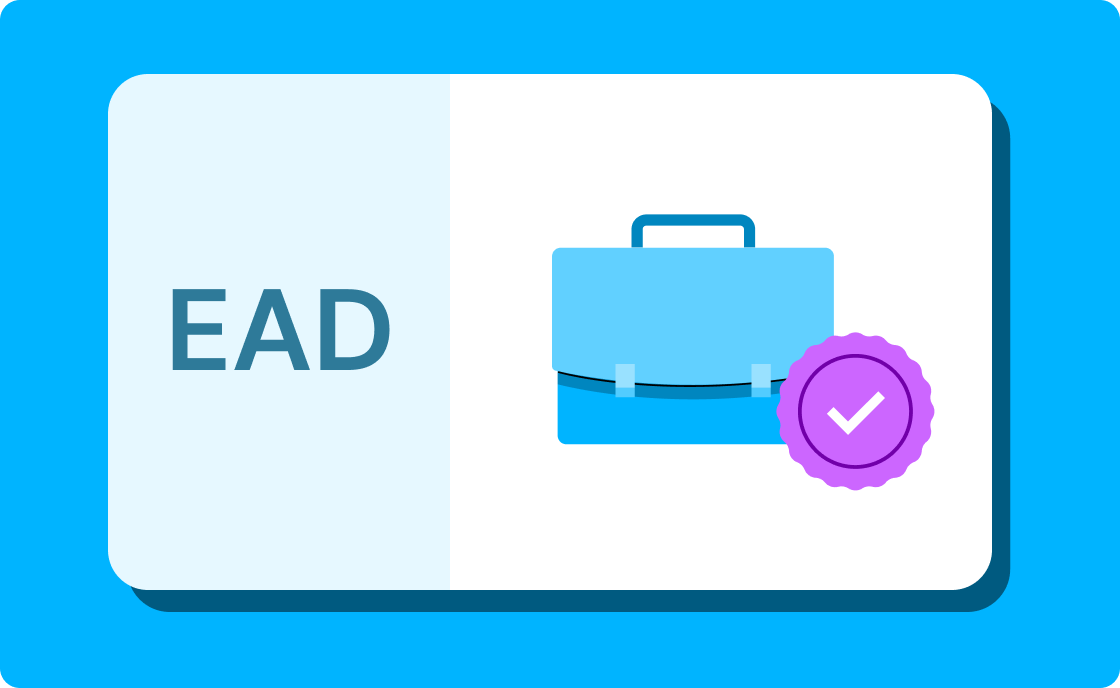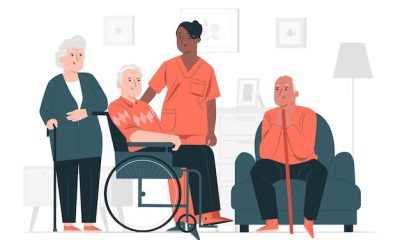Visa
US Work Permit: Guide To Obtaining An EAD Card For Temporary Work

Obtaining a visa that allows you to work in the United States is a lengthy process. It can take several months or more to study the documents, attend the interview, and receive a decision. Those with a nonimmigrant work visa in the United States must additionally get a work permit before they can begin working.
A US work permit can be of two types:
- Permanent US work permit
- Nonimmigrant visa US permit
This article will go through the nonimmigrant visa work permit and its details.
What is an EAD Card?
EAD cards, often known as work permits, are provided by USCIS to foreigners to authorize temporary employment in the US. When an EAD is authorized, USCIS delivers a card. The card looks like an ID card but allows you to work in the US.
A work driver’s license, the EAD. When you display your license, officials know you can drive. Employers know you may work in the US with an EAD.
If you already have a nonimmigrant visa but do not have an EAD, then any employer will not let you start working. Working without a valid EAD could lead to USCIS revoking your visa or you could get deported.
What Are the Requirements for an Employment Authorization Document?
To be eligible to get an EAD, you must fulfill a few criteria. The requirements and criteria are in the EAD Instructions in the USCIS website. As an overview, you must be in these categories to apply for the EAD:
- Asylee or Refugee and their dependents (spouse and children)
- Certain nationalities
- International students (such as F-1 visa or M-1 visa student)
- Eligible Dependents of Employees from International Organizations, Diplomatic Missions, or NATO
- Employment-Based Nonimmigrant (such as spouses of L-1 visa, or E-1 visa)
- Family Based Nonimmigrant (such as fiancé visa, or K-3 visa dependent)
- EAD applicant who has filed for an Adjustment of Status (you have applied for a Green Card)
Each category is described in detail on the EAD instruction form. You must read the instructions to determine which category you belong to. Making errors in the category may result in the rejection of your EAD.
The EAD is only available to people with a nonimmigrant visa in the United States. You do not need an EAD if you have an immigrant visa or a Green Card. Your Green Card functions as a work permit, allowing you to work.
How to Apply for an EAD?
To complete the EAD application, there are a few steps which you must follow, as outlined below.
Step 1: File Form I-765
Form I-765, Application for Employment Authorization is the main form for the EAD. It is available on the USCIS website and you must download it to start filling it out. Download the form right before you start applying because USCIS frequently makes changes.
The form will have space for you to provide your personal information and answer questions for your category. These questions will also determine the documents you will have to provide.
Step 2: Attach supporting documents
The documents you attach will serve as confirmation that you qualify for an EAD. Each category will necessitate extensive documentation. You must demonstrate your legal status in the United States, qualifications, and other documents through them. You must include them with the original Form I-765 that you will send to USCIS. Documents that must be attached include the following:
- A copy of the front and back of Form I-94, Arrival/Departure Record
- A copy of your last EAD. If you did not have an EAD before, you must submit a copy of a government issued ID such as a passport. The document must have your name, date of birth, and picture.
- Two identical passport-style photos of yourself. The photos must be within the last 30 days of you applying. You must print your name and Alien Receipt Number lightly on the back of each photo.
Other documents will be requested by USCIS based on your category. If you are seeking for an adjustment of status, you do not need to attach any supporting documents. If you are in such position, USCIS will already have the information on their system. Otherwise, supporting documents is required.
Step 3: Attach the fee receipts
We will go over how much the work permit costs and how to pay the charge in the sections below on the cost of the EAD. Regardless, you must include proof of payment with your application. If you do not provide proof that you have paid the filing and biometrics costs, USCIS will not process your EAD.
Step 4: Submit the application
After you have compiled your whole file, you can submit the EAD application to USCIS. There are two ways to file it:
- By mail
- Online through e-filing
If you submit by mail, be sure the address is correct. USCIS sites vary by state and category, so make sure you send it to the correct one.
If you use e-filing, you can fill out Form I-765 online and email it to USCIS. However, even if you apply online, your supporting documents must be mailed.
Remember to make a copy of the documents for yourself before submitting them. You may require them later if you apply for a renewal or if any of the information is lost.
What is the EAD Card Processing Time?
EAD processing usually takes around 60 to 90 days. USCIS will then send a notice whether they approved your EAD or not.
If they approve your application, then they will mail the EAD card to you. If they deny your EAD, you will get a notice telling you the reasons why you were not an eligible candidate.
How Much Does the EAD Cost?
The EAD application fees are in two parts:
- The filing fee which is $410
- The biometrics fee which is $85
So together, the EAD application will cost you $495. You can pay this fee through money order or check if applying by mail. If you apply online, they will also accept debit or credit cards. You cannot pay by cash though.
There are some categories which are exempt from the filing fee. These are:
- Asylees, Refugees or those Paroled as Refugees
- N-8 or N-9 nonimmigrants
- Citizens of Micronesia, Palau, or the Marshall Islands
- Those Granted Withholding of Deportation
- Victims of Severe Forms of Trafficking
- U-1 Nonimmigrants
- Those dependent of an international organization, foreign government, or NATO personnel
- Applicants for Asylum
- VAWA Self-petitioners
Also, if you are not in one of these categories, you can request a fee waiver from USCIS. You can file a waiver if you are in this situation:
- If you are eligible to file Form I-912, Request for Fee Waiver. You can check the instructions in the USCIS website to see if you qualify.
- You have supporting documentation to attach to the form that proves the following:
- You or someone living with you is currently receiving a means-tested benefit
- Your annual household income is below the 150% of the Federal Poverty Guidelines at the time of your filing
- You are experiencing financial hardships which do not allow you to pay the fees. Financial hardships can be if you have unexpected medical bills or emergencies.
You can prove you are in a means-tested benefit program if you are in programs such as:
- Medicaid
- Temporary Assistance to Needy Families (TANF)
- Supplemental Nutrition Assistance Program (SNAP or food stamps)
- Supplemental Security Income (SSI)
Some examples of programs that do not qualify as means-tested are:
- Medicare
- Social Security benefits
- Unemployment benefits
- Social Security Disability Insurance (SSDI)
- Student financial aid/grants/loans
- Retirement, Survivors and Disability Insurance (RSDI)
As for the biometrics fee, there are only three categories of people who must pay it. These are:
- Those requesting consideration for Deferred Action for Childhood Arrivals (DACA)
- Those who have approval for an employment based immigrant petition and have compelling circumstances
- Spouses or unmarried dependent children of beneficiaries who have approval for an employment based immigrant petition with compelling circumstances
Other categories are not required to pay the biometrics fee.
How Long is the EAD Valid?
After you receive your EAD and begin working, it is normally good for one year. When your EAD is about to expire, you must file a renewal application within 180 days of the expiration date. You can renew the EAD only once or many times, depending on the type of visa you have.
What if the EAD Has Incorrect Information On It?
If USCIS has issued your EAD but it has some incorrect information on it, you can file to have it corrected.
If the mistake was not due to a USCIS error, you must submit these documents:
- A new Form I-765
- The filing fees
- Supporting documents
- The card which has the mistake
If the mistake was due to USCIS error, then you do not need to submit a new Form I-765 or pay any new filing fees. You must submit:
- The card which has the mistake
- An explanation of the mistake
- Supporting documents which prove the correct information
What Kind of Health Insurance Am I Eligible For?
The type of health insurance you are eligible for as a temporary worker in the United States is determined by the length of your stay. The following are the various sorts of plans offered to international workers:
- Short-term insurance
- Long-term (domestic) insurance






















